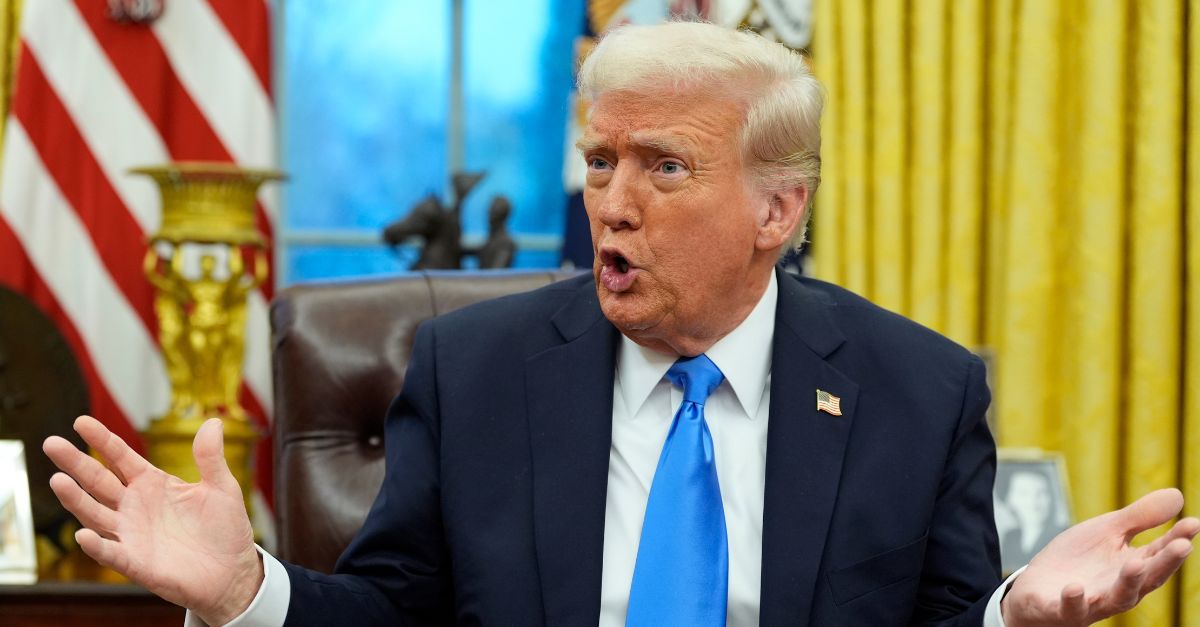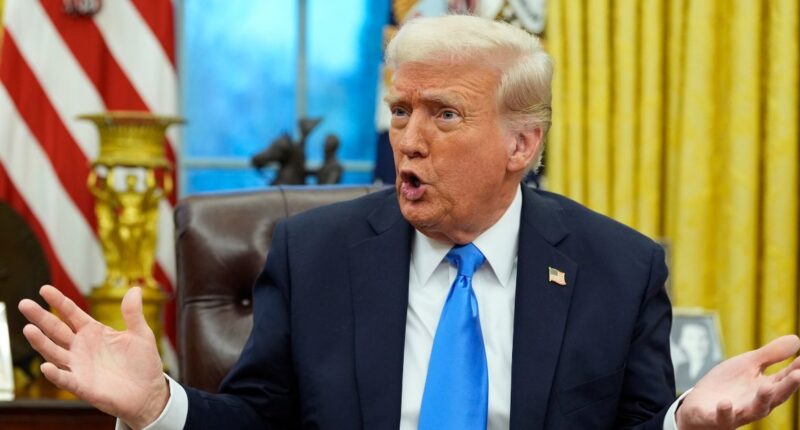
President Donald Trump speaks with reporters in the Oval Office at the White House, Tuesday, Feb. 11, 2025, in Washington. (AP Photo/Alex Brandon)
In this winter of political uneasiness, it is important to look back on Articles I, II and III of the United States Constitution.
In high school civics class, we learned that the first three articles of the Constitution lay out the structure of America’s government. Congress, known as the legislative branch, is responsible for making the country’s laws. The Supreme Court, or the judicial branch, is in charge of interpreting the laws, while the president, also known as the executive branch, enforces the laws.
Each branch is considered equal in power and contributes to a system of checks and balances. The Founding Fathers designed this system to prevent any one branch from becoming too powerful. This setup allows each branch of government to react to the actions of the others.
The president has the authority to veto laws passed by Congress, nominate individuals to lead federal agencies, and appoint Supreme Court justices. It is up to Congress to approve or reject the president’s choices. In unique situations, Congress also has the power to impeach and remove the president from office.
The justices of the Supreme Court, nominated by the president and confirmed by the Senate, can overturn unconstitutional laws.
For nearly 238 years this structure of checks and balances have held the “Great American Experiment” together, but the experiment has faced challenges in the past. Founding Father Thomas Jefferson, as president of the United States, was part of the first potential constitutional crisis when the Supreme Court in February 1803 decided the case of Marbury v. Madison, which established the principle of judicial review. Years later, in 1834, President Andrew Jackson, unhappy with a Supreme Court decision that favored Cherokee Indians in the region that would eventually become northern Georgia, is believed to have said of Chief Justice John Marshall: “[He] has made his decision; now let him enforce it.”
The Civil War saw the nation split in two. President Franklin D. Roosevelt decided to run for an unprecedented third and fourth term as president. In the 1950s, southern states defied the Supreme Court’s ruling against segregation in public schools. In more recent times, the country endured three presidential impeachments in 16 years.
Is America in a constitutional crisis today? Adam Liptak of The New York Times recently defined a constitutional crisis as “the product of presidential defiance of laws and judicial rulings.” Trump has signed more than 60 executive orders so far, the most in a president’s first 100 days in more than 40 years. As of this writing, Trump has been in office a little more than 30 days.
The orders, which Trump critics say greatly exceed his constitutional authority, range from tariffs on Mexico and Canada, to pauses on foreign aid and crackdowns on illegal immigration. Not to mention, bans on transgender people serving in the military or participating in athletics, revoking birthright citizenship, freezing federal spending, firing government employees who are subject to civil service protections and firing inspectors general — the government’s own watchdogs.
Saikrishna Prakash, a former clerk to conservative Supreme Court Justice Clarence Thomas who now teaches law at the University of Virginia told NPR, “The courts, you know, can issue orders and judgments, and, per the Constitution, I think the president is obligated to follow those orders and judgments. But, of course, there’s a practical question, which is how do you get someone to comply with the law?”
More than 10 federal courts have temporarily halted or rejected actions resulting from the new Trump administration’s actions. Last week, U.S. District Judge John McConnell found that the Trump administration has not fully followed his order to unfreeze federal spending and release billions of dollars.
However, statements by top Trump adviser Elon Musk and Vice President JD Vance appear to openly challenge judicial authority. The statements have raised concerns that the administration may ignore court rulings it opposes, reported the Brennan Center.
“It’s an open question whether the administration will be as contemptuous of courts as it has been of Congress and the Constitution,” Kate Shaw, a law professor at the University of Pennsylvania, told The New York Times.
In the first case to reach the Supreme Court in the wake of the onslaught of executive orders and actions taken within the first weeks of the new administration, lawyers for Trump have asked the justices to let him fire a government lawyer after a federal district judge ordered that the lawyer must be reinstated.
The Supreme Court has a 6-3 conservative bent. If the court constrains the president’s authority to fire government employees, Trump’s potential defiance of the court’s ruling could lead to a full-blown constitutional crisis unlike anything the country has ever experienced.
But if the Supreme Court capitulates to the president, the crisis may be even more grave. With the GOP kowtowing to Trump and in the majority in both houses of Congress and the Supreme Court not imposing any restraints, this country may well be slipping into the clutches of an authoritarian.
(Matthew T. Mangino is of counsel with Luxenberg, Garbett, Kelly & George P.C. His book The Executioner’s Toll, 2010 was released by McFarland Publishing. You can reach him at www.mattmangino.com and follow him on Twitter @MatthewTMangino)
This is an opinion piece. The views expressed in this article are those of just the author.






